| |
 |
September 2016 |
 |
|
| |
| |
|
Welcome
Welcome to the September issue of the USAPEEC ASEAN Regional Office’s newsletter.
This newsletter seeks to provide readers with useful product and major market information for institutional and consumer users of U.S. poultry. Readers will find in every issue a variety of general market information, program activities as well as useful product information.
This issue, we share several activities that took place in Southeast Asia.
Contents:
- The WOFEX Show 2016 in Manila
- U.S. Poultry Cooking Competition in the Philippine Culinary Cup
- Food Safety & Hygiene Seminars are Well-Received
- Long Queues for Vending Machine Meals
- Nimble Footed Retailers Latch on to Pokémon GO as a New Marketing Strategy
- Korean Wave in Southeast Asia
- Cold Dishes for Hot Weather
|
|
|
| |
|
|
|
| |
|
Additional Market Information Available
We have updated our website to include more information on market reports and export documentation guidelines.
You can visit our ASEAN website at: www.usapeecasean.com |
|
|
| |
|
|
|
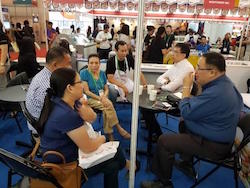 |
|
The WOFEX Show 2016 in Manila
The WOFEX Show 2016 took place at the SMX Convention Centre and the World Trade Centre in Manila during August 3-6, 2016. It is the premier food show in the Philippines. International and local exhibitors featured a wide range of food and beverage products including frozen meats, dairy products, fruit and vegetables, confectionery, packaged grocery products, alcoholic and non-alcoholic beverages.
The USA Poultry & Egg Export Council (USAPEEC) Pavilion attracted a considerable number of trade visitors during the four-day show. The pavilion showcased a wide range of U.S. chicken, duck and turkey products. USAPEEC partnered Hard Rock Café to prepare several poultry dishes for sampling. The Philippine Culinary Cup, Kitchen Theatre Stage Activities (product-based demonstrations by celebrity chefs), the World Food Summit and educational seminars were also held during the show.
|
|
Margaret Say in a group discussion with Philippine trade at the WOFEX Show 2016 |
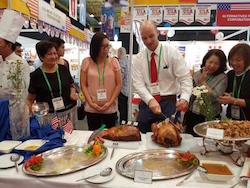 |
U.S Ag Attache Jeffrey Albanese cuts the U.S. turkey in opening of U.S. Pavilion. |
 |
Front section of USAPEEC Pavilion at the WOFEX Show 2016 |
| |
|
|
|
|
|
U.S. Poultry Cooking Competition in the Philippine Culinary Cup
The Philippine Culinary Cup, one of the main highlights at the WOFEX Show 2016, was held at the SMX Convention Centre during August 3-6, 2016 in Manila. The culinary competition is accredited by the World Association of Chefs and routinely attracts the best culinary talents. USAPEEC was the platinum sponsor for the competition. U.S. chicken leg quarters were featured as the star ingredient in the U.S poultry cooking segment of the competition. USAPEEC’s logo was featured on a large banner prominently displayed in the main competition hall as well as on all related collaterals. |
|
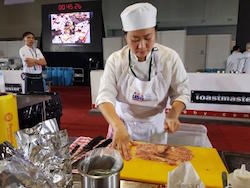 |
Philippine Culinary Cup contestant in poultry cooking segment |
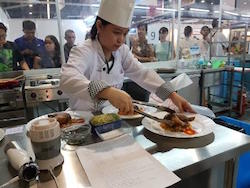 |
Another Philippine Culinary Cup contestant in the poultry cooking segment |
| |
|
|
|
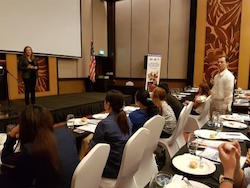 |
|
Food Safety & Hygiene Seminars are Well-Received
The Food Safety & Hygiene Seminar, a joint collaboration between the USDA office in Manila, and USAPEEC, were held on August 8 and August 10 in Manila and Cebu respectively. Dr. Shelly McKee, director of technical services in USAPEEC, presented the seminars to an audience of 70 participants in Manila, and over 100 participants in Cebu. Participants for the two seminars consist primarily of meat and poultry processors, and traders of mechanically separated meats. For the seminar in Cebu, participants came from as far as the outer islands in the Visayas group.
The seminars covered good manufacturing practices, sanitation standard operating procedures, food safety and hazard analysis critical control points, and quality, safety and safe handling practices of mechanically-separated poultry. The seminars were very well-received by the audience and some participants brought up thought-provoking technical questions on safe product handling and achievable salmonella bacteria levels. |
|
Dr. Shelly Mckee & Ralph Bean U.S. Ag Counselor at the seminar in Cebu |
 |
Participants in a session at the seminar in Manila |
| |
| |
|
|
|
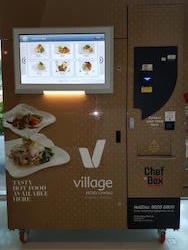 |
|
Long Queues for Vending Machine Meals
Singapore consumers endured an hour-long queue to try a diverse range of hot meals prepared by vending machines, which have been set up in selected public residential estates for the first time.
These vending machines sell hot local meals such as curry chicken, seafood ‘hor fun’ (rice noodles), ‘nasi biryani’ (spicy flavored rice with mutton, chicken or beef), and grilled salmon with spaghetti.
These meals are first prepared in a central kitchen and undergo a process known as blast freezing. They are subsequently delivered to the vending machines when required. Each vending machine is equipped with a built-in microwave oven, where it takes approximately three minutes to heat up each meal pack. Consumers highlighted its convenience and its 24-hour availability as the main benefit. |
|
Vending machine offering hot local meals
|
| |
|
|
|
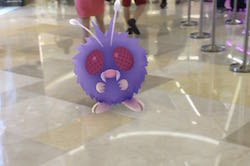 |
|
Nimble Footed Food Retailers Latch on to Pokémon GO as a New Marketing Strategy
Several major retail malls have climbed on to the Pokémon GO bandwagon by attracting Pokémon gamers with incentives to walk around the mall and post pictures of themselves in the shopping mall on their individual Instagram or Facebook accounts. The objective is to increase foot traffic and encourage visitors to at least take a look around the retail outlets and possibly purchase their meals and beverages in the mall. Pokémon ‘lures’ induce the presence of Pokémons to gather at different parts of the mall, motivating Pokémon players to wander around the mall to search for these Pokémons. In return, these shopping malls offer free beverages and a S$5 voucher in exchange for proof of a minimum of $50 purchase. A number of independent and chain restaurants have paid for ‘lures’ or have offered their locations as ‘PokéStops’ to allow gamers to load up on ‘Poké Balls’ for catching the virtual monsters. Incentives to Pokémon trainers include free beverages, discounts off meals, one for one meal offers, one or one free dessert for every meal ordered.
In addition to the shopping malls, a number of Singapore’s tourist attractions like Chinese Garden in Jurong, Botanic Gardens, Wildlife Reserves, Marina Bay Sands and Sentosa Island have been listed online as likely areas to capture Pokémons. More recently, Changi Village has also been highlighted as a hot venue for locating the less common and more highly sought after virtual monsters. Crowds of Pokémon players have been sighted in the early evenings along the stretch of the road fronting Changi Village, where they eagerly search for the exotic monsters available there.
|
|
A Pokémon is captured on a mobile phone
|
| |
|
|
|
 |
|
Korean Wave in Southeast Asia
Korean cuisine can be traced back to the Gojoseon Kingdom nearly 4,300 years ago1. Over time, Korean food has kept close to its traditional roots.
In recent years, the Korean wave has hit Southeast Asia with a bang. Back in 2012, South Korean singer PSY released the hit song; “Gangnam Style” that took the world by storm, with almost 2.6 billion views on Youtube2 to date. That was a trigger moment when the world began to pay more attention to K-pop culture. This played a tremendous role in influencing fans’ lifestyles, fashion and dining choices.
In 1997, there were only 20 Korean restaurants in Singapore. After the airing of K-drama “Jewel of the Palace” in 2005, this changed drastically. There are currently over 200 Korean restaurants, cafes and other eateries, not including hawker/food court stalls3. The majority of these restaurants serve barbequed meat, ‘samgyetang’ (chicken ginseng soup), ‘kimchi’ (fermented spicy cabbage), ‘naengmyeon’ (cold noodles) and many others. There are many neighborhood cafes that have been popping up all over Singapore selling ‘bingsus’ (cold desserts) and Korean-style fried chicken. The Korean cuisine is unique in its texture and flavor. Similar to Japanese cuisine, the Korean cuisine is also a labor intensive creation. It involves the preparation of different dishes that are harmonious as the various elements of the dish complements one another in a stellar meal.
The downside to the high growth of Korean restaurants is the cut-throat competition that restaurateurs have to face. Mr Tim Park, chief executive of Yellowsing, manages a website and mobile app that displays Korean restaurants here4. He shares that on average, three new Korean eateries open for every eatery that closes down per month.
An interesting aspect of Korean cuisine is the complimentary set of side dishes. Diners are served small complementary dishes of food upon arrival at their table. In Mexican restaurants, diners are served with free nacho chips and salsa. In Italian restaurants, diners will have some home-made bread to dip in balsamic vinegar.
In Korean restaurants, these side dishes are called ‘banchan’ and offered free-of-charge. It consists of a variety of side dishes for diners to choose from. When dining in a fancy Korean restaurant, they serve a premium range ‘banchan’ featuring beef, noodles, Korean pancakes and exotic fermented vegetables.
Many Korean dishes are cooked in similar ways and stay every close to the original recipes. The methods of preparation and preservation remained unchanged. For instance, ‘kimchi’ stemmed from the seventh century Korea and the methods they are prepared, fermented and consumed remains the same to date. The ultimate constituent of Korean culture lies in its rich heritage of delicious and unique cuisine5.
References:
1 The Korean Times (2008). Uniqueness of Korean Cuisine (I). [online] Available at: http://www.kscpp.net/LinkClick.aspx?fileticket=49TwvVYyqVM%3D
2 Youtube. PSY – Gangnam Style. [online] Available at: https://www.youtube.com/watch?v=9bZkp7q19f0
3 TODAY (2016). Korean restaurants boom in Singapore. [online] Available at: http://www.todayonline.com/singapore/korean-restaurants-boom-singapore?singlepage=true
4 TODAY (2016). Korean restaurants boom in Singapore. [online] Available at: http://www.todayonline.com/singapore/korean-restaurants-boom-singapore?singlepage=true
5 The Korean Times (2008). Uniqueness of Korean Cuisine (I). [online] Available at: http://www.kscpp.net/LinkClick.aspx?fileticket=49TwvVYyqVM%3D |
|
Several 'banchan' served in a Korean restaurant
Credit: Nancy |
| |
|
|
|
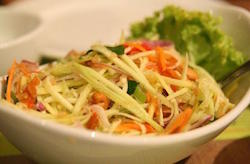 |
|
Cold Dishes for Hot Weather
Summer is in high gear for most of the world. In Southeast Asia, we get to enjoy summer all year round. Southeast Asians have learnt to beat the heat by keeping body temperature low and enjoy a cool meal or an iced drink. Here are some all-time favourites from around the region.
Salad: Yam Ma Muang (Thai mango salad)1
The Thai mango salad is prepared with julienned green mangoes, which gives the dish its refreshing sour base. Complemented with chopped peanuts, julienned carrots and red onion, dried shrimps, coriander, lime juice, and fish sauce; this dish offers up sweet, sour and tangy flavours. Often served chilled, the appetising flavours open up the palate for a meal.
Main course: Hainanese chicken rice2
Hainanese chicken rice is a dish that combines silky smooth boiled chicken with white rice cooked in a fragrant chicken broth. With its origins in the Hainanese migrant communities in Singapore or Malaysia, the dish is popular throughout the region. A critical factor in achieving the right texture for the chicken is the ice bath. Right after the whole cooked chicken is removed from the cooking pot, it is drained before being completely submerged in an ice bath for 10 to 15 minutes. The result is a cool, springy chicken dish accompanied by a satisfying bowl of chicken-flavoured rice.
Dessert: Steamed ginger egg custard3
Though not from Southeast Asia, the steamed ginger egg custard is well-loved by the Chinese community and has been popping up in dessert cafes around the region. Made with eggs, milk, sugar, and ginger juice, this delicate cold dessert from Hong Kong also offers up health benefits: ginger juice is believed to expel stomach wind and improve digestion.
Drink: Chè ba màu (three-coloured drink)4
Chè ba màu, or three-coloured drink, is an iced drink made up of coconut cream and three coloured ingredients. Common ones include green mung beans, white black-eyed peas, and red kidney beans, tapioca, coloured jelly and tropical fruits such as longan, lychee and mango. Sweet, cold, and representative of Southeast Asia, this dessert can be commonly found all over Vietnam.
References:
1 Spicy Thai Mango Salad For A Tongue Numbing Experience (13 February 2014). Available at: http://peepor.net/pint/blog/?p=6403
2 Hainanese Chicken Rice (8 August 2015). Available at: http://thewoksoflife.com/2015/08/hainanese-chicken-rice-%E6%B5%B7%E5%8D%97%E9%B8%A1/
3 Steamed ginger egg custard (15 May 2014). Available at: https://homemadeinhk.com/2014/05/15/steamed-ginger-egg-custard/
4 7 Asian Iced Desserts and Drinks (undated). Available at: http://smithsonianapa.org/picklesandtea/7-asian-iced-desserts-and-drinks/ |
|
Thai Mango Salad in hot weather
Credit: Reen |
|
Disclaimer: All opinions and views expressed in the articles published in the newsletter are those of the individual journalists and do not necessarily reflect those of the publisher, the newsletter's sponsors or USA Poultry & Egg Export Council.
You have received this email because you have registered to get newsletters from USAPEEC ASEAN.
If you prefer not to receive these updates, please
click here
to unsubscribe.
Do not reply to this email. For enquiries, go to www.usapeecasean.com
® USA POULTRY & EGG EXPORT COUNCIL
541 Orchard Road, #15-04, Liat Towers, Singapore 238881 Tel: (65) 67371726 Fax: (65) 67371727
*|REWARDS|* |
|
|
|